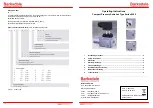
2
SALICRU
1. GENERAL CONFIGURATION.
Fig. 1.
General configuration menu.
1.
Connect: Click to start the communication between com-
puter and ATS.
2.
Company Name: Displays ATS company name.
3.
Model Name: Displays the ATS model name.
4.
Serial Number: Displays the ATS serial number.
5.
Firmware version: Displays the ATS firmware version.
6.
Cabinet Temperature: Displays internal temperature of ATS.
7.
Installation date: ATS installation date (month/day/year).
8.
Default: Click to recover all displayed parameters as default
values.
9.
Read: Click to read the setting information from ATS.
10.
Write: Click to write all setting values on the current page
to ATS.
11.
ID Number: It is for multi-units monitoring purpose.
12.
Input rating voltage:
Settable value for 110 V system: 100/110/115/120/127 V.
Settable value for 220 V system: 200/208/220/230/240 V.
13.
Input rating frequency:
Settable value: 50 Hz /60 Hz.
14.
Output current limit:
The setting value must be greater than 5 A and less
than the current rating of ATS.
15.
Preference source: It is for active ATS auto-return function.
N/A: Disable ATS auto-return function; which means
that the input power’s transfer action will only occur
when the current power source is abnormal.
Source A: ATS will transfer back to source A whenever
its power condition is normal.
Source B: ATS will transfer back to source B whenever
its power condition is normal.
16.
Delay recognized: It is a delay time before auto-return func-
tion acting.
Settable range: 3 sec ~ 60 sec.
17.
Auto Return Retry No. of Times:
Settable range: 1 ~ 99 times/hour.
The preference source will be changed to the other
source if the retry time exceeds the setting value.
ATS transfer to the other source while preference source
is abnormal; and then automatically transfer back when
preference source power recovered. The process above
will be seen as one automatic return cycle.
Example:
Preference source
A
Auto Return Retry no. of time
10
When the number of automatic return exceeds 10 times
within an hour, the system will automatically change
preference source as B.
18.
Synchronized Transfer Only:
NO: Phase difference between 2 power sources will be
ignored for transferring.


























